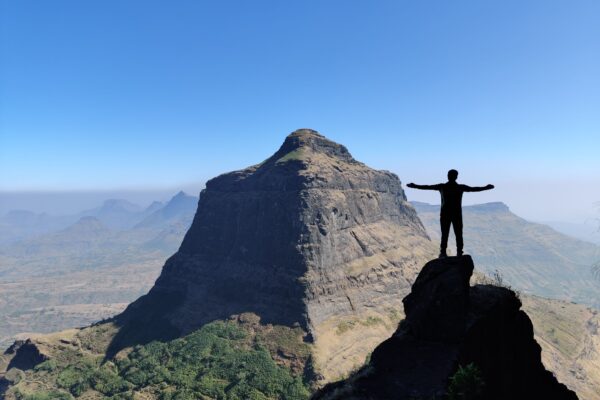
Top 10 Highest Forts of Maharashtra: A Journey Through History and Adventure
Maharashtra is a land of majestic forts, each standing tall as a testament to the rich history and heroic battles fought by the Marathas. From towering peaks to deep valleys, these forts are not only historically significant but also offer some of the most thrilling trekking experiences. In this guide, we’ll explore the Top 10 Highest Forts of Maharashtra, ranked by their elevation, and dive into the history, significance, and adventure they provide. Whether you’re a history enthusiast, an avid trekker, or someone seeking a thrilling escape into nature, these forts are sure to capture your imagination. 1. Salher Fort – The Highest Fort in Maharashtra Salher Fort is the highest fort in Maharashtra, standing proudly at 5,141 feet. This fort was the site of one of the largest battles between the Marathas and Mughals, making it a historically significant destination. For trekkers, Salher offers a challenging climb with steep, rugged terrain, especially towards the end. Once you reach the top, you’ll be rewarded with stunning panoramic views of the surrounding Sahyadri range, as well as a breathtaking view of the nearby Salota Fort. Why Visit? 2. Salota Fort – The Neighbor to Salher Located close to Salher, Salota Fort stands at 4,900 feet and offers a similarly challenging trek. The fort is less explored compared to Salher, giving trekkers a sense of isolation and tranquility as they explore the ruins and the beautiful landscape around. Why Visit? 3. Harishchandragad Fort – The Thrill of Konkan Kada Harishchandragad Fort is one of the most beautiful and thrilling forts in Maharashtra. Its most famous feature is the Konkan Kada, a cliff that offers stunning views of the surrounding valley. The trek to Harishchandragad is challenging, with steep climbs and rugged terrain that make it ideal for experienced trekkers. The fort also has historical significance, with ancient temples and caves that add to the charm of this destination. Why Visit? 4. Torna Fort – The First Conquest of Shivaji Maharaj Torna Fort, also known as Prachandagad, is one of the most significant forts in Maharashtra. It was the first fort captured by Chhatrapati Shivaji Maharaj at the age of 16, marking the beginning of the Maratha Empire. The fort offers sweeping views of the Sahyadri range, especially during the monsoon season when the surrounding area is lush with greenery. The trek to Torna is moderate to difficult, making it an exciting challenge for adventure enthusiasts. Why Visit? 5. Rajgad Fort – The Former Capital of the Maratha Empire Rajgad Fort was once the capital of the Maratha Empire under Chhatrapati Shivaji Maharaj and is known for its sprawling size and historical significance. The trek to Rajgad is challenging but incredibly rewarding, offering stunning views of the surrounding mountains. The fort itself is vast, with various points of interest such as Padmavati Temple, Suvela Machi, and Balekilla, which provide a glimpse into the grandeur of the Maratha Empire. Why Visit? 6. Ratangad Fort – The Jewel of the Sahyadris Ratangad Fort is known for its scenic beauty and its strategic location in the Sahyadris. The fort offers a thrilling trek through rocky terrain and lush forests. The fort’s natural rock formations, especially the Nedhe or “needle hole,” are a highlight for many visitors. Why Visit? 7. Panhala Fort – The Largest Fort in Maharashtra Panhala Fort is one of the largest forts in Maharashtra, known for its rich history and stunning architecture. The fort was an important strategic location during Shivaji Maharaj’s reign and offers a relatively easy trek compared to some of the other forts on this list. Why Visit? 8. Lohagad Fort – The Iron Fort Lohagad Fort is known for its unique Vinchu Kata (Scorpion’s Tail), a long and narrow ridge that extends from the fort and offers stunning views of the surrounding region. The fort is one of the easiest to trek and is perfect for beginners. Why Visit? 9. Pratapgad Fort – The Victory Fort Pratapgad Fort is famous for the historic battle between Shivaji Maharaj and Afzal Khan. The fort offers stunning views of the nearby hills and valleys, making it a popular destination for trekkers and history enthusiasts. Why Visit? 10. Shivneri Fort – The Birthplace of Shivaji Maharaj Shivneri Fort is the birthplace of Chhatrapati Shivaji Maharaj, making it a significant historical site. The trek to Shivneri is relatively easy, making it accessible for beginners, and the fort offers panoramic views of the surrounding area. Why Visit? Conclusion Maharashtra’s forts offer a unique blend of history, adventure, and natural beauty. From the highest fort at Salher to the historically significant


